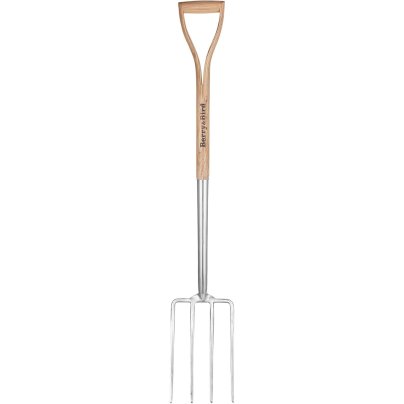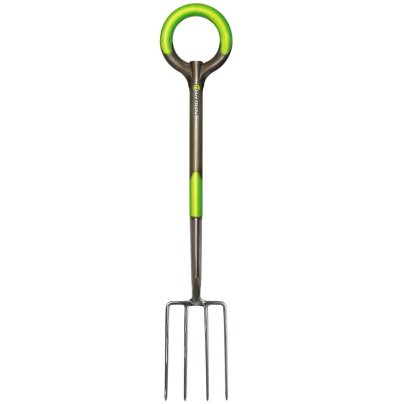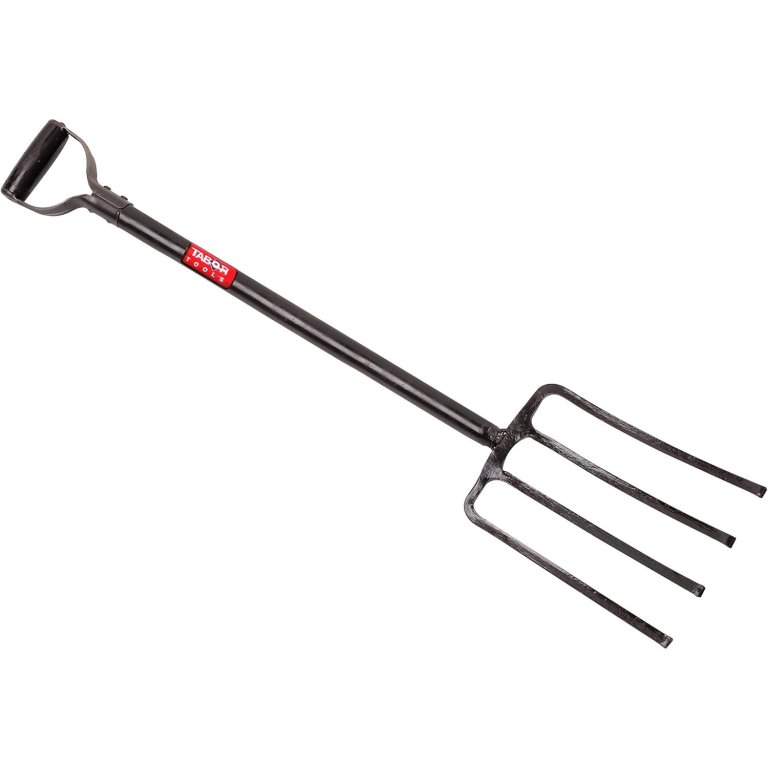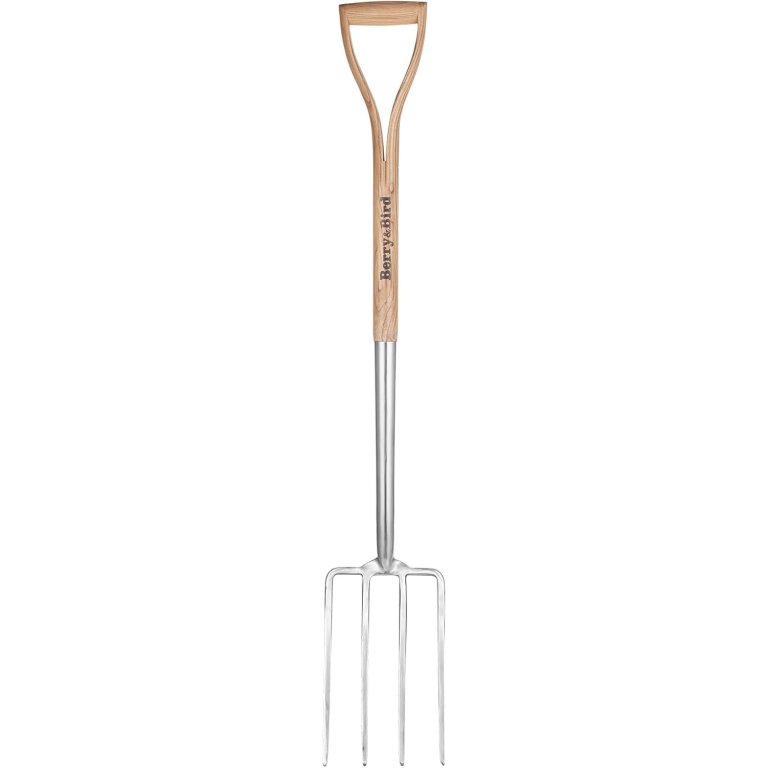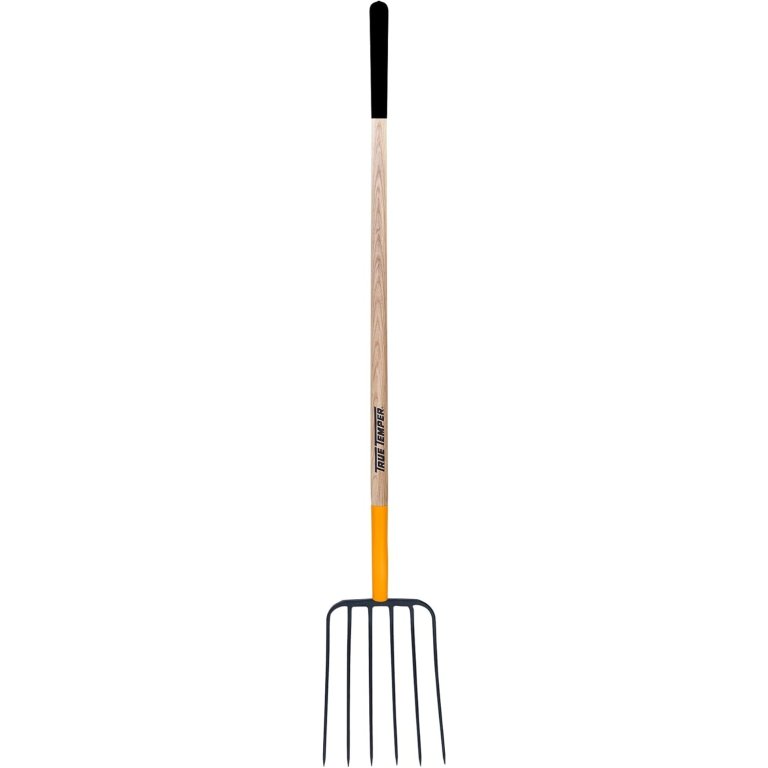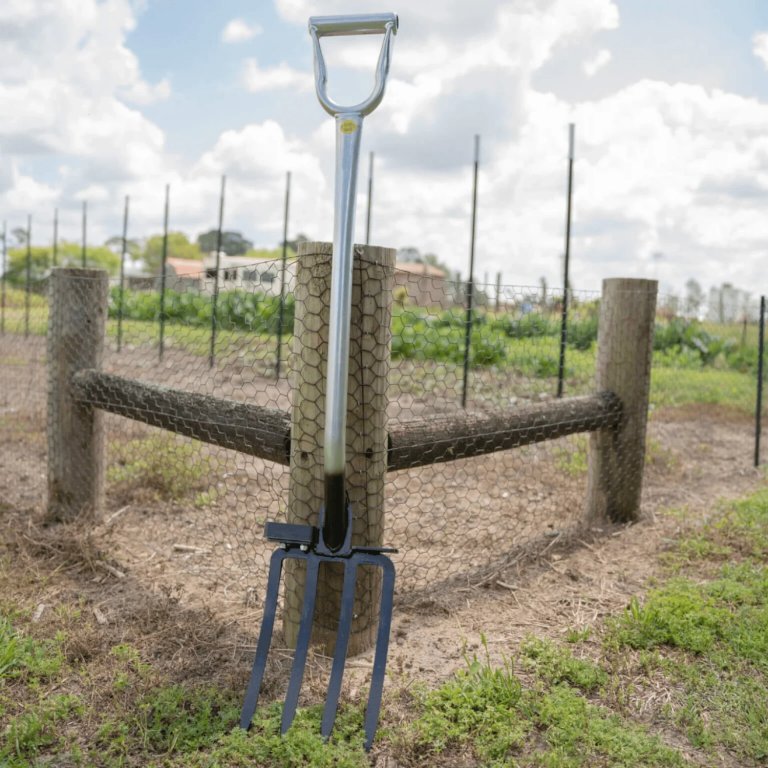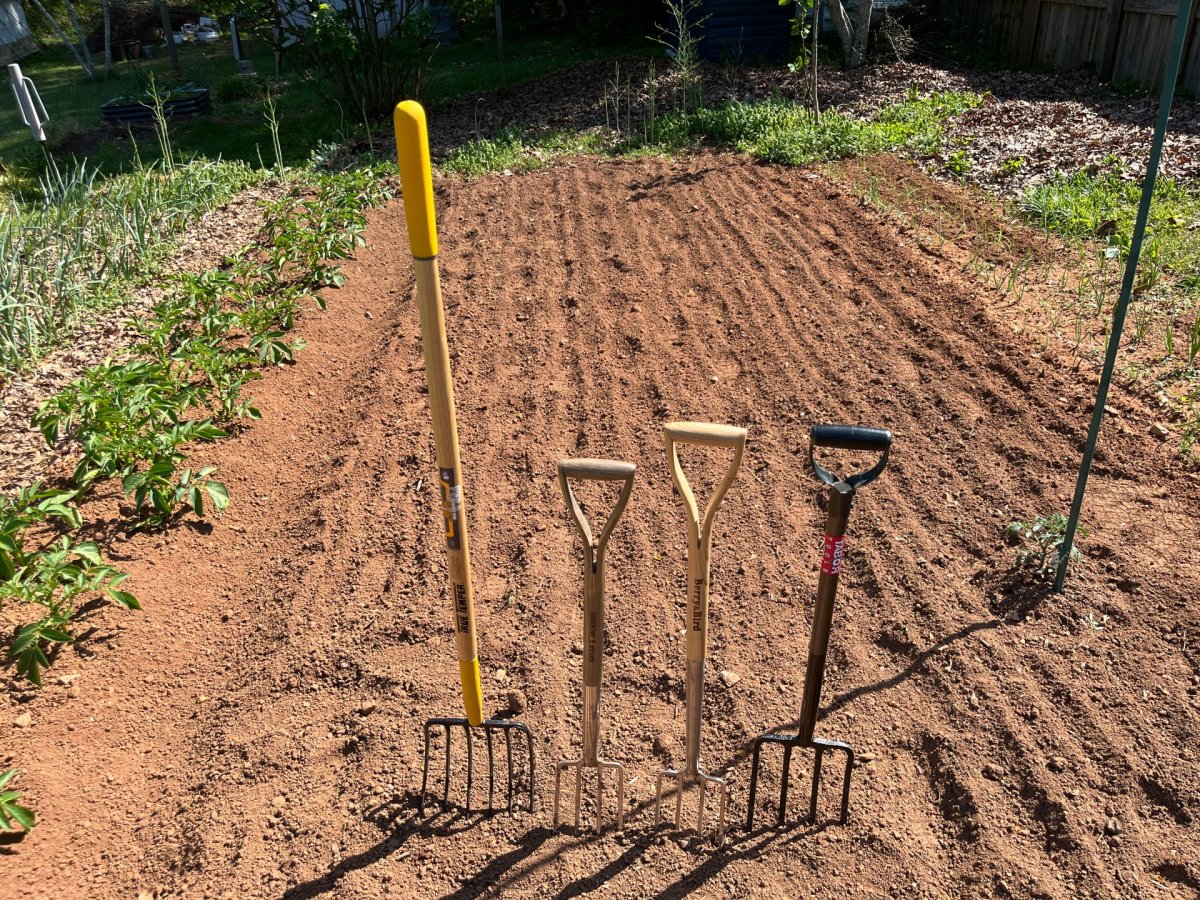
We may earn revenue from the products available on this page and participate in affiliate programs. Learn More ›
A good garden fork is one of the most valuable tools for gardening and yard work. Whether it’s for preparing a garden bed, planting, cultivating, composting, or harvesting, these rugged and versatile tools outperform spades and shovels when it comes to tackling the most difficult lawn care and gardening tasks, as well as other delicate work. But there are several different types of forks for gardening, so we created this guide to help you find the right one for your projects. To do so, we put five different garden forks through a series of rigorous tests and then evaluated them for performance, ergonomics, durability, and overall value.
Our top pick, the rugged all-steel Tabor Tools Digging Fork, was the best performer overall. It broke up compacted soil surprisingly well, lifted root vegetables out of softer soil without damaging them, and proved capable of turning compost. But it was heavier than the others, and it had a much larger head that made it less suitable for working among closely spaced plants.
Others in our tested group might work better for those who need a strong but lightweight garden fork, or one that is better suited for working in confined spaces. Read on for our tool recommendations, along with our reviews of the ones we tested. Later in the guide, we offer shopping tips to help select the best garden fork for your outdoor projects.
- BEST OVERALL: Tabor Tools Digging Fork
↓ Jump to Review - BEST BANG FOR THE BUCK: Berry & Bird Stainless Steel Garden Digging Fork
↓ Jump to Review - BEST ERGONOMIC: Radius 203 Pro Stainless Steel Digging Fork
↓ Jump to Review - BEST BORDER FORK: Spear & Jackson Traditional Border Fork
↓ Jump to Review - BEST COMPOST FORK: True Temper 6-Tine Manure Fork
↓ Jump to Review - BEST BROADFORK: Bully Tools Broadfork With Fiberglass Handles
↓ Jump to Review - BEST FOR CULTIVATING: Edward Tools Hoe and Cultivator Hand Tiller
↓ Jump to Review - BEST HEAVY-DUTY: Hoss Garden Fork
↓ Jump to Review

Garden Forks Comparison Chart
| Product | Type | Length | Weight |
| Tabor Tools Digging Fork | Digging fork | 40 inches | 5.5 pounds |
| Berry & Bird Garden Digging Fork | Border/spade fork | 37.4 inches | 3.5 pounds |
| Radius 203 Pro Stainless Steel Digging Fork | Digging | 42.5 inches | 5.1 pounds |
| Spear & Jackson Traditional Border Fork | Border | 37.5 inches | 3 pounds |
| True Temper 6-Tine Manure Fork | Manure fork | 60.75 inches | 5.5 pounds |
| Bully Tools Broadfork With Fiberglass Handles | Broadfork | 56 inches | 11.8 pounds |
| Edward Tools Hoe and Cultivator Hand Tiller | Combination tool | Not provided | 0.9 pounds |
| Hoss Garden Fork | Digging fork | Not provided | 5.5 pounds |
Our Top Picks
Regardless of the size of the garden or your gardening style, any of these forks could be a great choice. They’re all high-quality tools designed to provide years of dependable service. In the product reviews ahead, we share our observations from testing, as well as the pros and cons we experienced while working with each tool.
Best Overall
Photo: AmazonWhat We Like
- Extremely strong, durable construction
- Flat tines work surprisingly well in compacted soil
- Good height for most users
- Impressive cost value
What We Don’t Like
- One of the heaviest forks we tested
- Less nimble when working among delicate plants
Specs
- Type: Digging fork
- Length: 40 inches
- Weight: 5.5 pounds
Our Ratings
| Ergonomics | 4.5/5 | Performance | 4.8/5 | Durability | 5/5 | Value | 4.8/5 |
forks are often distinguished by the shape of their tines, which suits them for different tasks. Normally, forks meant for breaking up packed soil have tines with square profiles, while those designed to sift through loose soil have a more or less flat shape. This heavy-duty digging fork from Tabor Tools offers the best of both worlds. It features extra-strong tines that are flat across the front and rounded at the back to work efficiently in both compacted and loose soils, making it our top choice for general-purpose garden digging.
This all-steel fork was one of the heaviest we tested, which was an added benefit when breaking ground, but it was a bit tiring when we had to scoop up soil and debris. We could not imagine an accident or other scenario that would seriously damage it, and it’s pretty much weatherproof. The large head made it easier to scoop up bigger loads of soil and debris than others. Also, the flat-faced tines did a nice job of loosening and picking midsize rocks out of the soil, which was our simulation for harvesting root vegetables that were not in season at the time of testing.
What our tester says: “I found the Tabor Tools fork to be an awesome digger, and the soil condition didn’t seem to matter. It was strong enough to grind through dry, compacted clay, and wet, sticky soil really didn’t stick to the tines that badly. Lifting it over and over could get tiring, but that sort of work is not typical anyway. For general forking, this is the one.”—Mark Wolfe, Product Reviews tester and writer
Get the Tabor Tools garden fork at Amazon or Tabor Tools.
Best Bang For The Buck
Berry & Bird Stainless Steel Garden Digging Fork
Buy at AmazonWhat We Like
- Narrow head maneuvers well between delicate plants
- Taller fork reduces bending
- Durable stainless steel head
- Strong, lightweight hardwood handle
What We Don’t Like
- Wooden handles are less wear and weather resistant than steel
Specs
- Type: Border/spade fork
- Length: 41 inches
- Weight: 3.5 pounds
Many gardeners prefer the natural look and feel of a traditional hardwood handle with a stainless steel head. The Berry & Bird spading fork includes those popular features and weighs just 3.5 pounds to boot. The deep socket design reinforces the wood handle for added strength in an otherwise weak point, ensuring that this fork will withstand daily use. And did we mention that it was the most affordable garden fork we tested?
Digging with this narrow-headed fork was a pleasure. It easily penetrated packed earth, and we had no problem working through a densely planted perennial garden without damaging the plants. The stainless tines were extremely resistant to soil buildup. The small head was less efficient than larger forks when it came to scooping, but it worked fine in that capacity for limited use, and the lightweight build made it a little easier to do so.
As with other wood-handled tools, this one should be stored when not in use. Extended sun and moisture exposure will quickly degrade the wood otherwise. With basic care, though, it should last many years.
Get the Berry & Bird garden fork at Amazon.
Best Ergonomic
Photo: AmazonWhat We Like
- The circular handle is very comfortable
- Strong and durable resin-encased steel shaft
- Square-profile tines easily penetrate compacted soil
- Good height for most users
What We Don’t Like
- One of the heavier forks we tested
Specs
- Type: Digging
- Length: 42.5 inches
- Weight: 5.1 pounds
Our Ratings
| Ergonomics | 5/5 | Performance | 4.5/5 | Durability | 4.5/5 | Value | 5/5 |
Boasting a rugged steel construction and a unique ergonomic design, this digging fork promises a long working life and a less-stressful user experience. Its large loop handle provides an easy grip at various angles, with or without work gloves, while the carbon steel shaft and stainless steel head add ample strength for all kinds of digging. The colorful thermoplastic exterior gives the carbon steel portions weatherproof protection and a comfortable, grippy surface for the user.
This tool performed well in all the tests, but like the other small-head forks, it proved slightly less efficient in material handling. Weighing a little over 5 pounds, this was one of the heavier forks tested. The added weight was helpful for breaking ground, but it was a little less user-friendly when lifting was involved. The square steel tines were perfectly designed for penetrating and breaking up heavy soil clods.
The big difference between this fork and the other small-headed varieties was its ergonomic handle. The large loop felt more comfortable and offered more grip angles than conventional Y-D type handles.
Get the Radius Pro garden fork at Amazon, The Home Depot, or Walmart.
Best Border Fork
Photo: AmazonWhat We Like
- Strong, lightweight build
- Small head for working in confined spaces
- Polished stainless steel head minimizes soil adhesion
- Great size for raised bed gardening
What We Don’t Like
- Less comfortable for taller users
Specs
- Type: Border
- Length: 37.5 inches
- Weight: 3 pounds
Our Ratings
| Ergonomics | 4.5/5 | Performance | 4.5/5 | Durability | 5/5 | Value | 4.7/5 |
The Spear & Jackson border fork could be a perfect fit for those who need a garden fork that is smaller, lighter, and more precise for working in gardens and other confined areas. With a 5.75-inch-wide head, it measures just 37.5 inches tall overall and weighs almost exactly 3 pounds. This is an ideal spading fork for aeration of shrub roots, working raised beds, and weeding between garden plants.
This was the easiest fork of those we tested to maneuver almost anywhere in the garden. Our tester was able to work comfortably in either a standing or kneeling position as the project required. The mirror-finished stainless steel head did an excellent job of repelling sticky soil, preventing weight accumulation. Although its hardwood handle gives it a lightweight build, the deep socket head adds support in the high-leverage lower parts of the shaft. At no point during testing did it feel as though it would break under pressure, although we would not attempt to use it for heavy-duty prying.
Although a digging fork with a longer handle and larger head might be preferable for soil preparation in a wide-open garden bed, we preferred this one for maintenance in the already growing areas.
What our tester says: “I really liked how ruggedly the little Spear & Jackson border fork performed considering its compact, lightweight build. It was perfect for weeding, picking rocks, aerating, and transplanting without disturbing nearby plants.”—Mark Wolfe, Product Reviews tester and writer
Get the Spear & Jackson garden fork at Amazon, Lehman’s, Michael’s, or Walmart.
Best Compost Fork
Photo: AmazonWhat We Like
- Long, straight handle reduces bending
- Springy round tines penetrate smoothly without sticking
- Scoop-shaped tines for easier lifting
- Good choice for turning or moving wet, clumpy materials
What We Don’t Like
- Not for digging in compacted soil
Specs:
- Type: Manure fork
- Length: 60.75 inches
- Weight: 5.5 pounds
Our Ratings
| Ergonomics | 5/5 | Performance | 4/5 | Durability | 5/5 | Value | 4.5/5 |
Some garden forks are not really designed for digging. This True Temper long-handled fork features long, round-profile tines with a scoop-shaped head. This is a perfect tool for turning compost piles, spreading mulch, and occasionally lifting perennial weed runners from well-tilled soil. It features a long straight handle that allows the user a longer reach with less bending.
As noted above, the tines on this fork pierced the soil only when we needed to remove fresh Bermuda grass shoots from a prepared garden bed. The long, skinny tines reached deep and plucked out the thick stolons without much problem. Otherwise, we used this fork for moving large piles of weeds and debris and turning compost, which it did better than any other fork in the test group. The long, thin tines penetrated to the base of the weed pile and easily picked up a huge mound of debris. The long, straight handle allowed us to do it while standing upright.
It is important to note that the tines on this fork are quite different from those on the other forks tested. In addition to being longer and having a round profile, they are much thinner. Unlike the stout digging forks, the springy nature of this fork is not a good fit for digging but a great fit for material handling.
Get the True Temper garden fork at Amazon or Ace Hardware.
More Great Options
We tested several of the most popular types of gardening forks, but there are others that better suit different needs. Although the following picks have not been tested by our team, they come with outstanding reviews and solve different problems.
Best Broadfork
Bully Tools Broadfork With Fiberglass Handles
Buy at Amazon Buy at Tractor Supply Buy at the Home DepotWhat We Like
- Excellent tool for large-scale digging
- Tough triple-wall fiberglass handles
- Very good leverage
What We Don’t Like
- Relatively heavy
- Expensive
Specs
- Type: Broadfork
- Length: 56
- Weight: 11.8 pounds
This broad digging fork from Bully Tools tackles the same tasks as a standard garden fork, but on a larger scale. On top of that, it can help complete the same garden chores as narrower tools, but in less time. Broadforks are also useful as potato forks, which were once a popular alternative but are now seldom seen.
The 42.25-inch handles are detachable for convenient storage. With heavy-duty fiberglass handles, 10-gauge steel tines, and commercial-grade construction, this tool is durable and will last for years.
Get the Bully Tools garden fork at Amazon, Tractor Supply Co, or The Home Depot.
Best For Cultivating
Edward Tools Hoe and Cultivator Hand Tiller
Buy at AmazonWhat We Like
- Great versatility
- Durable high-carbon steel
- Rubber-covered grip absorbs impact
What We Don’t Like
- Handle needs oiling occasionally
- Some reports of broken tines
Specs
- Type: Combination tool
- Length: Not provided
- Weight: 0.9 pounds
Minimalist gardeners or those without much storage space might gravitate toward multipurpose tools. This garden fork from Edward Tools serves as both a hand tiller and a garden hoe, so users only need to carry around one tool for multiple jobs.
The two-sided garden fork and hoe features carbon steel blades and a grippy rubber handle. The fork is ideal for tackling tasks in the summer vegetable or flower garden. When efficiency is important, this multipurpose tool is easy to carry along.
Get the Edward Tools garden fork at Amazon.
Best Heavy-Duty
Photo: AmazonWhat We Like
- Fabricated from heat-treated steel
- Flat tines for digging and lifting
- Wide step area with interchangeable foot pad
- Designed and made in USA
What We Don’t Like
- Premium price for a heavy-duty tool
Specs
- Type: Digging fork
- Length: Not provided
- Weight: 5.5 pounds
Need a truly heavy-duty garden fork that can reliably break up tough soil? The Hoss Garden Fork is up to the task. Fabricated completely from heat-treated steel, this is a tough and versatile tool for digging and turning even the toughest clay soil. The flat tines are perfect for harvesting root crops, cultivating, and incorporating compost.
We like all-steel forks for their overall durability. This one features an oversize D-handle that should fit most hand sizes, even while wearing work gloves. The wide foot pad on the upper part of the head is another nice feature that will help to prevent the foot pain that sometimes comes with long hours of digging. The pad can be mounted on the right or left side to match the user’s preference. Although we haven’t tested it yet, this fork appears to be a great harvesting tool for potatoes, onions, carrots, and the like.
Get the Hoss garden fork at Amazon or Hoss.
Jump To Our Top Picks
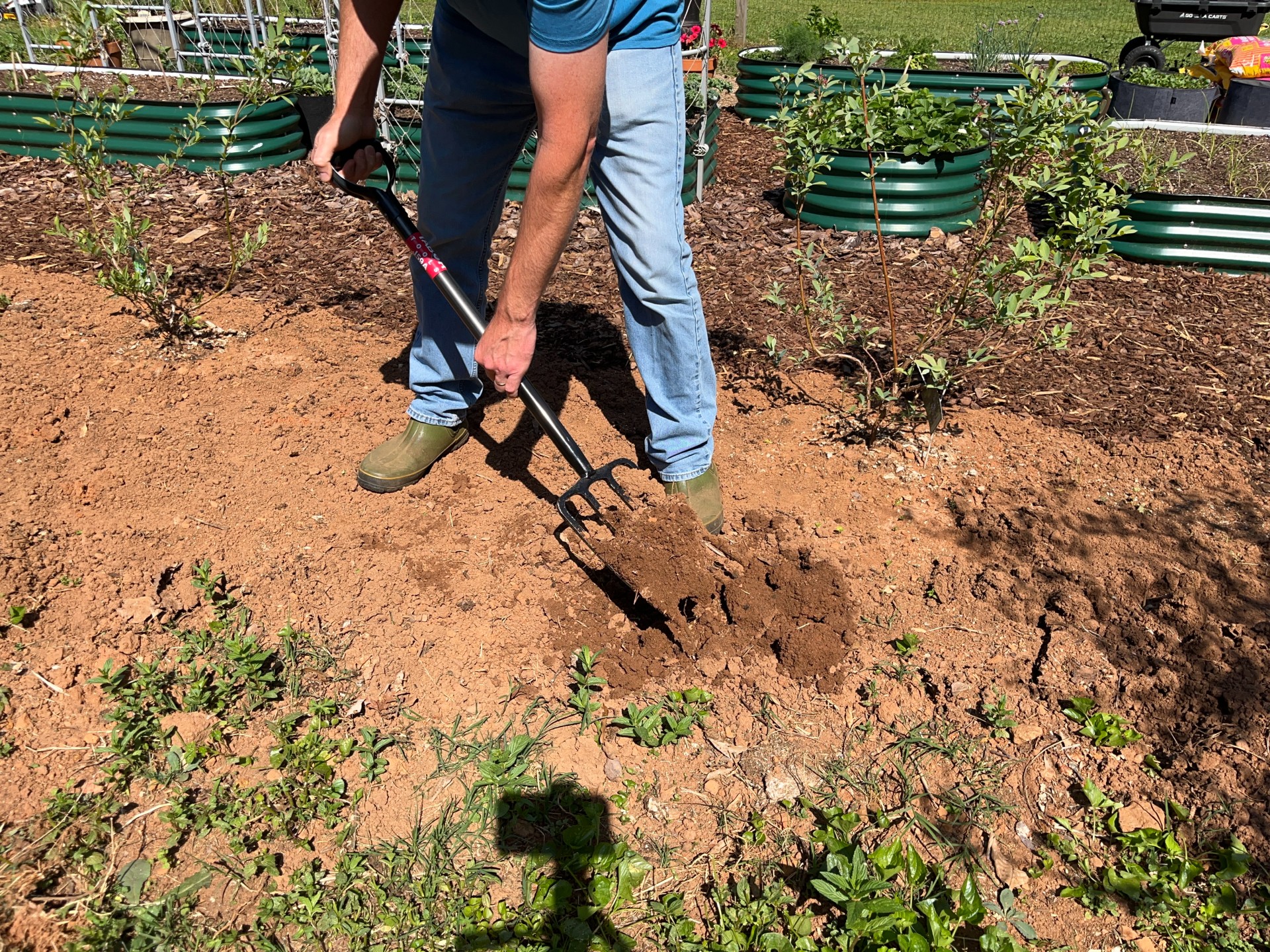
How We Chose and Tested the Best Garden Forks
After choosing five highly rated garden forks to test, we spent a week using them in the garden. Our goals were to find out how each of the different models would perform in a variety of typical chores, which one might work best for general-purpose use, and whether the others might be better suited for specific tasks. We spent at least 2 hours with each one, loosening compacted soil, digging planting holes, cleaning up garden borders, and scooping up debris. Afterwards, we recorded our observations and preferences on a scoring rubric before choosing each category’s winners.
| Product | Ergonomics | Performance | Durability | Value | |
| Tabor Tools Digging Fork | 5/5 | 5/5 | 5/5 | 5/5 | |
| Berry & Bird Stainless Steel Garden Digging Fork | 5/5 | 5/5 | 5/5 | 5/5 | |
| Radius 203 Pro Stainless Steel Digging Fork | 5/5 | 4/5 | 5/5 | 5/5 | |
| Spear & Jackson Traditional Border Fork | 5/5 | 5/5 | 5/5 | 5/5 | |
| True Temper 6-Tine Manure Fork | 5/5 | 5/5 | 5/5 | 5/5 |
What to Consider When Choosing a Garden Fork
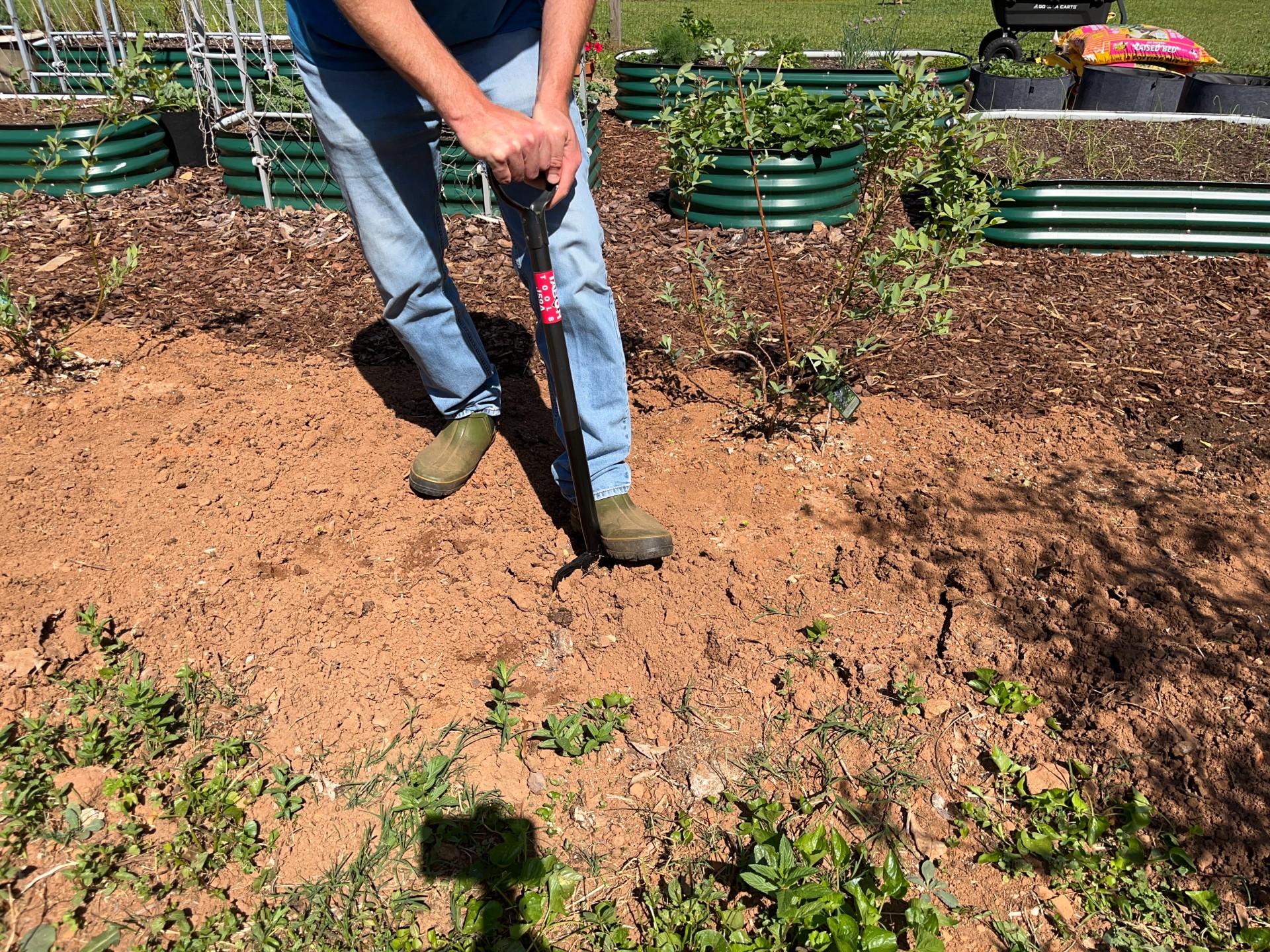
Among common gardening tools, forks are one of the most versatile. Gardeners can use a single fork for digging, turning, weeding, transplanting, and even aerating the lawn. There is a great variety of garden forks to consider, though. To help choose the best garden fork for your needs, we’ll look at what sets them apart and explore the benefits of each type.
Type
There are six types of gardening forks, each of which serves a variety of purposes:
- Standard garden forks usually have four square or round tines. These garden forks are designed to dig into the soil and move dirt, compost, or mulch as needed. They have a slight curve to make it easier to scoop dirt.
- Digging forks are meant for penetrating the soil and are ideal for loosening compacted earth. These garden forks usually have between four and six tines with no curves.
- Spading forks (a name sometimes used interchangeably with digging forks) have four flat-faced, robust tines designed for heavier tasks, such as breaking up dense soil. While often considered a type of digging fork, they’re typically shorter and stronger than standard garden forks.
- Border forks are usually smaller, lightweight versions of the standard garden fork, designed for working in confined spaces, such as flower borders, or for incorporating compost into already well-prepared ground. Historically, they have also been called ladies’ forks.
- Broadforks often have five or more tines and two separate pole handles that provide a great deal of leverage. They can be used for lawn aerating or digging over a vegetable plot.
- Hand forks are compact tools suitable for loosening up small patches of dirt around small plants and seedlings, as well as pulling weeds. These garden forks typically have three tines.
Durability
Because garden forks often get little care and can be left out in all types of weather, durability is crucial. Additionally, most have to withstand considerable leverage. If the fork shaft breaks, it is not only inconvenient but could also result in back strain or other injury.
The tines and the back of the fork are typically made of steel, though the type of steel can vary. Stainless steel is strong and resists corrosion. Boron steel is very hard. Hand forks might be pressed from a steel sheet as an entire piece. Larger forks frequently have either forged steel tines or welded tines for additional strength.
Traditionally, shafts and handles were made from hardwood, which costs less than other materials and feels good in the hand. Unfortunately, wood can split if it is not properly cared for. As a result, many modern garden forks have steel, fiberglass, or polypropylene shafts and handles, which are both stronger and less affected by damp or cold. A solid steel shaft usually has some kind of plastic or resin cover for added comfort.
Ergonomics
A quick glance at many garden forks will reveal that handles come in different shapes. Additionally, a line drawn from the handle, down the shaft, and through the tines is often far from straight. Each of these elements affects ergonomics, which in turn influences both user comfort and the power generated.
T-shape and D-shape handles are common, though the former is more often found on garden spades and shovels. The D shape has long been the standard for a firm grip and easy turning. The handles often tilt forward slightly to reduce wrist strain. More recently, O-shape handles have appeared; their proponents claim they reduce stress on the wrist and hands, though gardeners might need some time getting used to gripping them.
Shafts often have a slight bend near the bottom to aid leverage. Tines may also have a forward curve, which can help with lifting, though straight versions are often considered stronger.
Length and Weight
Length can be important for ergonomics and effectiveness; the best length depends on the type of fork and the work that is done most often. Border forks are lightweight and typically a little shorter, measuring around 36 to 38 inches, making them easier to maneuver in and around plantings. These garden forks aren’t designed for heavy digging.
Many of the standard garden forks we looked at are around 40 inches long. This doesn’t seem much larger than a border fork, but it’s a significant difference when digging for longer periods. While 40 inches is considered a good average, taller gardeners or farmers may want a longer fork, and we have seen models up to 53 inches. It is very much a question of personal preference.
Whether the weight of a garden fork makes much difference will depend on how well it is designed and the physicality of the user. Border forks with wooden handles are usually among the lightest. A stainless steel garden fork is often seen as a sign of quality, though these tend to be the heaviest. However, if the ergonomics are good and the tool is comfortable to use, the actual weight will have minimal impact.
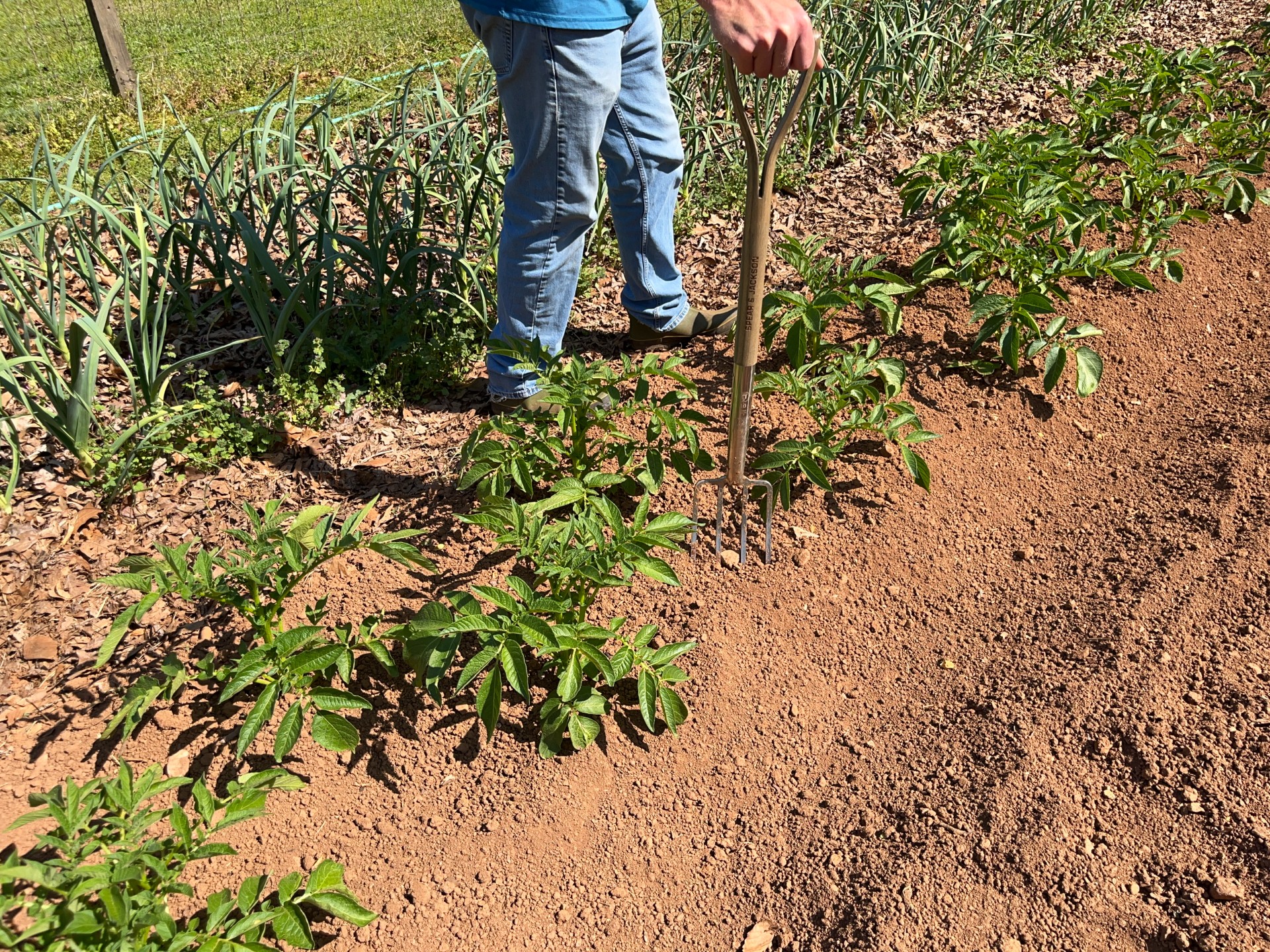
FAQs
We hope that the above information has provided you with lots of valuable information. During our research, a few questions came up frequently. While these may have been touched on above, we’ve collected them here for your convenience.
A pitchfork isn’t a digging tool but is used for lifting straw, hay, grass, etc., either loose or as bales. It can also be used for clearing manure and bedding from stables, for example. It usually has a longer handle to maximize leverage and two or three slender tines. A garden fork is shorter and normally has four tines, which are thicker and stronger for digging. Garden forks are sometimes called pitchforks, though that isn’t really correct.
A digging fork is a general-purpose tool. A border fork is a smaller, lighter version that is easier to use if space is restricted, which is often the case in a border filled with flowers and shrubs.
Consider how often you will use the garden fork, typical tasks you might need to complete, and budget. You also might want to look at length and weight, especially if physicality, ergonomics, or height are issues.
Push the tines in with your foot, pull the handle back to lever the soil loose, and then break up clumps by striking them with the back of the fork. If the soil is compacted or heavy clay, attempting to move too much could strain your back. Work 6 inches of soil at a time.
Boiled linseed oil rubbed into wooden fork handles with a rag will feed the wood and shed water so the handles last longer. Wiping a little of the oil over metal parts will help to prevent rust. Though not as good for the wood, light machine oil could also be used.
Unlike a garden spade, which can benefit from periodic sharpening, there is seldom a need to sharpen a garden fork. Sharp tines do make working soil easier, but they are usually very durable and wear very little. If you feel the need to sharpen a garden fork, a file or handheld grindstone will do the job.

